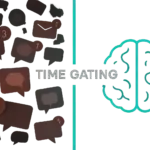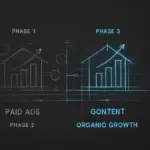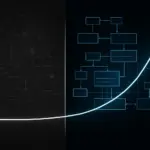Most marketing case studies feel like they were written after the fact—because they were. They show you the polished „after“ photo but conveniently hide the messy, uncertain process of getting there. You see the 408% traffic growth but not the six months of failed campaigns that came before it.
This project is different.
JvG-Thoma.com is the living documentation of how we are evolving a niche German engineering brand from a reliance on paid traffic to a position of trust-based authority. It’s not a retrospective case study; it’s a series of ongoing field notes. I’m documenting the system as we build it—the clean wins, the frustrating plateaus, and the strategic pivots.
The search landscape is filled with comprehensive guides from agencies like Gorilla76 and impressive results-focused reports from firms like SmartBug Media. They offer either a perfect, static blueprint or a glossy photo of a finished building. We’re showing the day-to-day construction because we believe the most valuable insights are found in the messy middle.
The Core Challenge: Industrial Marketing is a Game of Trust
JvG-Thoma builds solar module production lines. The sales cycles are long, the decisions are complex, and the stakes are high. Trust isn’t a bonus; it’s the entire foundation.
Industry data shows that 57% of industrial buyers make a purchase decision before ever speaking to a salesperson. Our website, content, and digital footprint must do the heavy lifting of building that initial confidence. This project documents our deliberate, systematic approach to tackling that exact problem.
Our journey isn’t a random collection of tactics. It’s a calculated four-phase evolution designed to build a scalable marketing system that balances short-term validation with long-term brand equity.
Our Four-Phase System: From Rented Attention to Owned Authority
We designed this system to evolve, starting with high-intent channels to validate our message and then progressively layering on strategies to build a lasting brand asset.
Phase 1 – The Foundation: Validating Demand with Paid Search
Before building a complex content engine, we had to answer a fundamental question: Does our market even search for solutions online? We used Google Ads not as a lead generation machine, but as a clean, efficient tool for gathering market intelligence.
Our focus was painfully simple:
- Test Message-to-Market Fit: Did our core value propositions resonate?
- Validate Keyword Relevance: What specific language did potential clients use?
- Establish a Conversion Baseline: Could we convert targeted traffic into an initial inquiry?
The goal wasn’t immediate scale; it was to get a clear signal from the market. This phase gave us the data and confidence to invest in the next, more complex stage.
Phase 2 – The Struggle: Cracking Meta Ads for a Hyper-Niche Audience
This is where our assumptions were tested—and where most of our early learning happened. We knew Meta Ads could work for B2B, but our initial campaigns, focused on technical specifications and product features, fell flat. The cost per lead was unsustainable.
The breakthrough didn’t come from a new targeting hack. It came from a fundamental shift in perspective. Meta isn’t a search engine where you fulfill existing demand; it’s a discovery platform where you have to interrupt a scroll and spark new interest.
We had to stop talking like engineers and start talking about the problems our customers face. This struggle forced us to refine our messaging in a way no other channel could have, and those insights now inform our entire content strategy.
Phase 3 – The Pivot: Building the Asset of Trust with Content
With a predictable flow of inquiries from our refined paid channels, we earned the right to invest in the long game: content. Research consistently shows that content marketing generates over three times as many leads as traditional marketing at a fraction of the cost. We see this not as an expense but as the construction of a core business asset.
We shifted focus from ads that sell to content that serves, publishing articles and building landing pages focused on:
- Our Company Philosophy: Why we build things the way we do.
- Our Process & Technology: Demystifying complex engineering concepts.
- Customer Stories: Showcasing the real-world impact of our work.
The goal here isn’t direct response. It’s to build a library of resources that positions JvG-Thoma as the definitive authority in our space and creates a foundation for long-term organic growth.
Phase 4 – The Payoff: Observing Early Organic Signals
This is the phase we are currently navigating. As our trust-based content library grows, we’re beginning to see the first signs of organic traction—impressions, clicks, and rankings for non-branded, problem-aware keywords.
This isn’t about replacing our paid campaigns. It’s about building a hybrid system where organic visibility supports and amplifies our paid efforts. The content answers questions that build trust, warming up an audience that may later be retargeted with a direct offer. This organic layer is our long-term moat, reducing our dependency on ad spend and creating a self-sustaining growth engine.
Why Document This Publicly?
In a world of polished agency pitches, we believe radical transparency is the ultimate differentiator. By documenting our process in real-time, we’re not just building a marketing system for JvG-Thoma; we’re creating an open-source playbook for any founder or operator trying to build a modern industrial brand.
This is our commitment to showing the work.
Frequently Asked Questions
How long does a transition from paid ads to a hybrid model take?
Realistically, this is a 12- to 24-month journey. Phases 1 and 2 can provide initial validation and leads within the first three to six months. However, seeing meaningful results from the trust-building content in Phases 3 and 4 requires patience. Organic authority compounds slowly at first, then all at once.
Isn’t it risky to rely so heavily on paid ads at the start?
It’s riskier to spend a year building content for an audience that doesn’t exist or a message that doesn’t resonate. We use paid ads as a calculated tool to mitigate that risk, quickly validating demand and messaging with real-world data before committing to larger investments in long-term assets like content.
Our industrial niche is „boring.“ How can we create engaging content?
No niche is boring to the people who work in it. The key is to stop trying to make it „exciting“ and start being genuinely useful. We don’t create content about our machines; we create content about the problems our machines solve for our customers. Your expertise, when shared generously, is inherently engaging to the right audience.
How do you measure the ROI of „trust content“?
Direct ROI is the wrong metric in Phase 3. Instead, we measure leading indicators of trust:
- Organic Impressions & Rankings: Are we becoming visible for key industry topics?
- Time on Page & Engagement: Are people reading and consuming our expertise?
- Assisted Conversions: Does data show that users who consumed content later converted through another channel?
The ultimate ROI is a shorter sales cycle and a higher close rate because prospects arrive already convinced of our expertise.
Follow the Project
This page serves as the anchor for the JvG-Thoma project. Each phase will be broken down into specific, detailed updates documenting our tests, frameworks, and findings. Follow along as we continue to build and refine this system in public.




